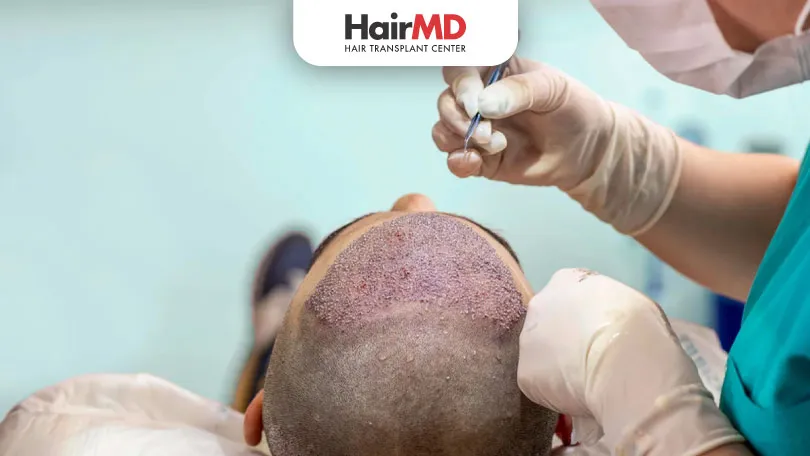
Wondering if a hair transplant procedure is painful? Learn about the discomfort levels, pain management techniques, and what to expect during recovery.
Ever wondered if you can move hair from one place to another? Hair is a huge part of our confidence, but sometimes things like stress or genetics cause it to fall out, leading to hair loss. If you’re looking for a way to restore your locks, hair transplants might be the answer. Keep reading to learn everything you need to know about this procedure.
What’s covered in the article?
- What is Hair Transplant Procedure?
- Eligibility for Hair Transplant
- Does Hair Transplant Treatment Hurt?
- Frequently Asked Questions
- Conclusion
What is Hair Transplant Procedure?
Thinking about a hair transplant? Here’s what you need to know:
What is it? Hair transplantation involves moving healthy hair follicles from one area of your head (usually the sides or back) to a balding or thinning area, especially the crown.
Why the crown? Hair loss on the crown is often linked to “androgenic alopecia,” more commonly known as pattern baldness.
- For men: This typically means receding hairlines and bald patches.
- For women: It often presents as thinning hair, particularly along the central part of the scalp.
Two main methods: There are two primary types of hair transplant procedures, chosen based on your specific hair loss condition:
-
- Follicular Unit Strip Surgery (FUSS)
- Follicular Unit Extraction (FUE)
Ready to explore your options and say goodbye to hair loss?
Eligibility for Hair Transplant
Considering a hair transplant? Here’s who typically qualifies:
Eligible Candidates:
- Pattern Baldness: Men with hair loss on the crown and women with thinning hair are ideal.
- Scalp Scars or Burns: Individuals with non-thick or non-fibrous scars or burns on the scalp.
- Sufficient Donor Hair: Those with enough healthy donor hair sites where hair loss is not widespread.
Non-Eligible Candidates:
- Hair Loss from Chemotherapy or Radiation: Patients undergoing these treatments are not suitable.
- Insufficient Donor Hair: If there aren’t enough healthy hair follicles to transplant.
- Severe Scalp Scars: Individuals with thick, fibrous tissue from severe burns or scars.
Does Hair Transplant Treatment Hurt?
A hair transplant is a surgical procedure typically performed by a surgeon or a Hair Specialist in Pune in a clinical setting. Many people are anxious about the procedure, often due to a fear of needles. However, the treatment is designed to be as painless as possible.
Before the surgery begins, the patient receives local anesthesia. This numbs the scalp, ensuring you don’t feel pain during the procedure. Once the area is numb, the surgeon begins the process. They carefully remove hair follicles from a “donor area”—usually the back and sides of your head, where hair tends to be denser. These follicles are then meticulously implanted into the “recipient area,” which is where the hair is thinning or has been lost.
After the procedure is finished, it’s normal to experience some discomfort, swelling, or soreness as the anesthesia wears off. To manage this, your doctor will likely prescribe medications, such as:
- Pain relievers to manage any post-surgical pain.
- Anti-inflammatory drugs to reduce swelling.
- Antibiotics to prevent infection at the surgical sites.
It is crucial to follow your doctor’s post-operative instructions carefully. In the rare event that you experience excessive bleeding, signs of infection (like increased redness or pus), or severe inflammation on your scalp, you should contact your dermatologist immediately.
Are you experiencing significant hair loss and considering a permanent solution? Book your consultation with HairMD. Our experienced dermatologists will walk you through the entire hair transplant procedure, answer all your questions, and ensure your treatment is as comfortable and painless as possible.
Frequently Asked Questions
1. Is a hair transplant painful?
No, a hair transplant is not painful because the procedure is performed under local anaesthesia. You may feel mild discomfort or pressure, but not pain during the surgery. Any post-procedure soreness is usually manageable with prescribed medications.
2. How long does the pain last after a hair transplant?
Most patients experience mild soreness or tightness in the scalp for 2–3 days after the procedure. Discomfort gradually subsides as the scalp heals, and by the end of a week, most people feel completely fine.
3. Which hair transplant technique is less painful – FUT or FUE?
The FUE (Follicular Unit Extraction) method is generally considered less painful because it involves minimal incision and no sutures. The FUT (Follicular Unit Transplant) technique may cause slightly more post-operative discomfort due to the linear incision.
4. What can I do to reduce pain after a hair transplant?
Follow your doctor’s instructions carefully. Take prescribed pain relief medicines, avoid scratching or touching the scalp, sleep with your head elevated, and stay away from strenuous activities for a few days.
5. Is anaesthesia used during a hair transplant safe?
Yes, local anaesthesia used in hair transplant procedures is completely safe when administered by a qualified surgeon. It helps ensure a painless and comfortable experience during the surgery.
Do You Know?
Nearly 250 Patients Visit HairMD
Everyday For Various Hair Concerns?
(Your journey to healthier and fuller hair starts here!)
Meet Our Dermatologists
Conclusion
In conclusion, a hair transplant procedure typically involves minimal discomfort due to local anesthesia and modern techniques. Any mild pain or soreness experienced during recovery is temporary and can be managed with prescribed medications. If you’re considering a hair transplant, it’s important to discuss pain management options with your surgeon to ensure a comfortable experience and smooth recovery.
Further Reading
Low-Cost Hair Transplant Clinics in Pune – Risks & Warnings
Discover why ultra-low-cost hair transplants in Pune are dangerous. Learn red flags, true costs, and how to verify surgeon credentials before risking your scalp health.
Top Hair Growth Treatments for Women: Your Ultimate Guide
Find effective hair regrowth treatments for women. Explore solutions like PRP, medications, and more to combat hair loss with expert advice from HairMD.
FUE vs FUT Hair Transplant – Pune Specialists Compare
Compare FUE vs FUT hair transplant techniques, costs, recovery, scarring, success rates, and ideal candidates. Learn which method suits you best in Pune.
Relation Between Masturbation and Hair Loss
Is there a relation between masturbation & hair loss? Uncover truth with our detailed analysis, separating fact from fiction to provide clarity on this common concern.
Have thoughts? Please let us know
We are committed not only to treating you, but also educating you.










